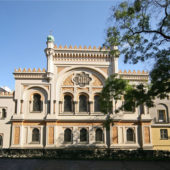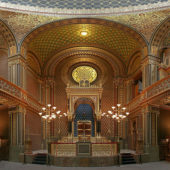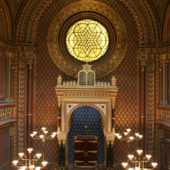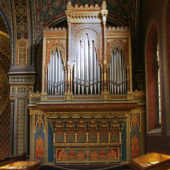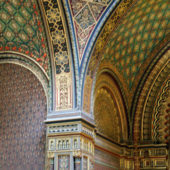A striking example of Moorish-style architecture and decoration.
Built in 1868 on the original site of the historic Altschul (Prague’s oldest synagogue), the so-called Spanish Synagogue is a striking example of Moorish-style architecture that became somewhat fashionable for European synagogues in the mid to late 19th century. The distinctive lines, patterns and colors of the Moorish style are immediately apparent both in the exterior and interior of the synagogue with the stucco arabesques adorning the walls and other Islamic motifs such as flowers and geometric patterns in reds, blues and greens found throughout the building.
The synagogue, according to a pamphlet written by a congregation member in the 1930s, was designed by Vojtěch Ignátz Ullmann while architects A. Baum and B. Münzberg designed the stained glass windows and interior. Work on the synagogue, which was located just outside the Jewish Ghetto in Prague, was completed in 1893. Incidentally, the city decided to tear down the old ghetto that same year.
In recent times, however, scholars have questioned Ullman’s credentials as principal architect of the synagogue, citing lack of original documentation as well as evidence pointing to other architects and subcontractors who may actually have done the work. *Nevertheless, the Reform synagogue became home to many of Prague’s most prominent and well-to-do Jewish families.
While the Moorish style alone certainly makes the synagogue distinctive among those in Prague, there are other deviations from typical synagogue layout that adds to the Spanish Synagogue’s interesting character. Most older synagogues, for instance, feature a central bimah with seating arranged along the walls. The Spanish Synagogue has benches arranged in rows in the center, much like a Christian church.
Although the Moorish styling suggests the name “Spanish Synagogue” the synagogue itself did not receive that appellation until the 1960s. In fact, it was called the “Israelite Temple of Prague” until it was given in 1959 to the Prague Jewish Museum by the Czech government’s Ministry of Health. Scholars believe the name Spanish Synagogue derives rather from the Iberian, or Sephardic, roots of the congregants whose ancestors were expelled from Spain in 1492.
The synagogue, which stored Torah curtains during the Holocaust, sat empty for two decades in the late 20th Century, before being restored and reopened in 1998, the 130th Anniversary of its founding. Today it is a popular tourist destination and serves as the headquarters of the Jewish Museum in Prague. Prague’s Jewish population is estimated to number about 5,000 as of 2006.
*Ivan Kalmar, University of Toronto, Origins of the Spanish Synagogue of Prague, 1999

